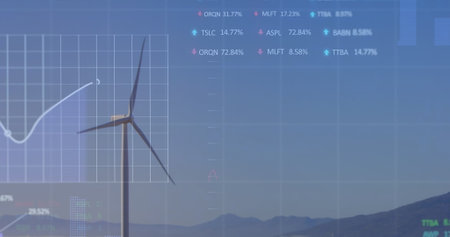Introduction to Renewable Energy Infrastructure in the UK
The United Kingdom’s renewable energy sector has undergone a remarkable transformation over the past decade, positioning itself as one of Europe’s leading markets for clean energy investment. This evolution is underpinned by ambitious national targets, robust government support, and a rapidly changing technological landscape. The UK government has committed to achieving net zero carbon emissions by 2050, driving a significant shift away from fossil fuels and towards low-carbon alternatives such as wind, solar, and tidal power. Key policy instruments—including Contracts for Difference (CfD), the Renewables Obligation (RO), and targeted subsidies—have played a pivotal role in de-risking investments and incentivising large-scale deployment of renewable infrastructure. Additionally, the UK boasts some of the world’s largest offshore wind farms and is home to pioneering innovation in grid integration and storage solutions. Recent market developments highlight a surge in institutional capital, an increase in corporate power purchase agreements (PPAs), and growing interest in emerging sectors like hydrogen and battery storage. Collectively, these factors have reshaped the risk-return profile for investors in UK renewable energy infrastructure, making it imperative to understand the unique dynamics that characterise this market.
2. Risk Factors Affecting Renewable Energy Investments
When considering renewable energy infrastructure investments in the UK, it is critical to evaluate a spectrum of risks unique to this market. Investors must navigate a complex interplay of market dynamics, regulatory frameworks, technological advancements, and environmental considerations. Each risk category presents distinct challenges and opportunities, influencing both short-term project viability and long-term return on investment.
Market Risks
The UK renewable energy sector is influenced by fluctuating power prices, evolving demand patterns, and competition from both conventional and emerging energy sources. Market risks can be heightened by shifts in consumer behaviour or the integration of renewables into the National Grid, which may impact project revenues and financing conditions.
Key Market Risks in the UK
| Risk Factor | Description | Impact |
|---|---|---|
| Wholesale Price Volatility | Unpredictable changes in electricity prices due to market supply-demand imbalances. | Revenue uncertainty for projects reliant on merchant power sales. |
| PPA Availability | Access to long-term Power Purchase Agreements may fluctuate with market sentiment. | Difficulty in securing stable cash flows. |
| Grid Constraints | Bottlenecks or delays in grid connection and capacity allocation. | Potential delays or curtailment of generation output. |
Regulatory Risks
The UK government’s commitment to net zero by 2050 underpins policy support for renewables; however, shifting subsidy schemes, planning approvals, and changing carbon pricing mechanisms all introduce regulatory uncertainties. Investors must stay abreast of policy developments at both national and devolved government levels.
Main Regulatory Risks in UK Renewable Projects
- Changes to Contracts for Difference (CfD) terms or allocation rounds
- Evolving permitting processes for onshore and offshore developments
- Post-Brexit legislative adjustments impacting cross-border energy trade
Technological Risks
While the UK is at the forefront of wind and solar innovation, technology risks persist. These include potential underperformance of novel solutions, supply chain disruptions, or accelerated obsolescence as new standards emerge. Robust technical due diligence is required to mitigate these exposures.
Examples of Technological Risks
- Turbine blade degradation in offshore wind farms due to harsh marine conditions
- Delays in battery storage deployment linked to supply shortages or lack of skilled labour
- Lack of interoperability between legacy grid systems and new digital control technologies
Environmental Risks
The environmental profile of each project site impacts both construction timelines and ongoing operations. Key considerations include biodiversity constraints, local community opposition, and increasing scrutiny from stakeholders regarding sustainability credentials.
Summary Table: Primary Environmental Risks in UK Renewables
| Risk Type | Description | Pertinent Example |
|---|---|---|
| Biodiversity Impact | Potential harm to protected habitats or species during development. | Delays due to bird migration routes affecting offshore wind planning consent. |
| Climate Variability | Unpredictable weather patterns influencing resource availability. | Diminished solar PV yields during prolonged overcast periods. |
| Community Opposition | Local resistance affecting project acceptance and timelines. | Council rejection of onshore wind farms in scenic areas like Scotland’s Highlands. |
A comprehensive understanding of these risk dimensions is essential for investors aiming to optimise returns while supporting the UKs transition towards a low-carbon economy. Rigorous risk assessment enables more resilient financial modelling and enhances stakeholder confidence in renewable infrastructure projects across the country.

3. Evaluating Financial Returns and Performance Metrics
When investing in renewable energy infrastructure in the UK, a rigorous assessment of financial returns and performance metrics is essential for making informed decisions. The evaluation process typically begins with analysing projected cash flows and calculating key financial indicators such as the internal rate of return (IRR) and net present value (NPV). These metrics provide a quantitative basis for comparing renewable projects to traditional investments and gauging their overall profitability.
Payback Periods: Balancing Risk and Reward
The payback period remains a fundamental metric for investors seeking to understand how quickly they can recover their initial capital outlay. In the context of UK renewables, payback periods can vary significantly between technologies—onshore wind and solar PV may offer shorter returns compared to offshore wind or tidal power, largely due to differences in capital intensity and operational costs. Investors should also factor in government incentives, feed-in tariffs, and Contracts for Difference (CfDs), which can materially affect cash flow timing and reliability.
Levelised Cost of Energy (LCOE): A Benchmark for Competitiveness
The Levelised Cost of Energy (LCOE) serves as a crucial yardstick for assessing cost competitiveness across different energy generation sources. LCOE represents the average total cost to build and operate a renewable asset over its lifetime, divided by the total energy output. For UK-based assets, LCOE calculations must account for site-specific variables such as resource availability, grid connection costs, and local planning requirements. Notably, recent government auctions have driven LCOEs lower for offshore wind and solar PV, enhancing their investment appeal relative to fossil fuel alternatives.
Other UK-Relevant Performance Indicators
Beyond headline metrics, investors should scrutinise additional performance indicators including capacity factor, operational availability, and maintenance expenditures. The capacity factor—measuring actual output versus theoretical maximum—can be influenced by UK weather patterns, technological reliability, and grid constraints. Moreover, financial models must incorporate currency risk (GBP volatility), inflation indices (such as RPI or CPI), and evolving regulatory frameworks. Local content requirements and community engagement policies may also impact project economics, particularly in devolved administrations like Scotland or Wales.
Towards Data-Driven Investment Decisions
In summary, evaluating financial returns in the UK renewables sector demands a nuanced approach that integrates traditional investment appraisal tools with sector-specific insights. By systematically benchmarking payback periods, LCOEs, and a suite of operational metrics against UK market realities, stakeholders can more accurately balance risk and reward while supporting the nation’s transition to net zero.
4. Mitigation Strategies for Investment Risk
Investing in renewable energy infrastructure in the UK presents a unique blend of risks and opportunities. To achieve an optimal risk-return profile, investors must deploy robust mitigation strategies tailored to both market dynamics and project specifics. This section explores key risk mitigation solutions, including insurance products, diversification approaches, contractual frameworks, and government support mechanisms.
Insurance Solutions
Comprehensive insurance coverage is a critical tool for mitigating operational and construction-related risks. Investors typically utilise policies covering physical damage, business interruption, and liability to safeguard against unforeseen events such as equipment failure or natural disasters. Insurance not only protects cash flows but also enhances the overall bankability of projects.
Diversification Approaches
Risk can be significantly reduced by diversifying across different technologies, locations, and counterparties within the UK energy landscape. A well-diversified portfolio helps absorb sector-specific shocks—such as changes in wind patterns or solar irradiance—and regulatory adjustments at regional levels.
| Diversification Dimension | Example | Risk Reduction Benefit |
|---|---|---|
| Technology | Combining wind, solar, and biomass assets | Smooths out variability in generation and revenue streams |
| Geography | Projects spread across England, Scotland, and Wales | Lowers exposure to region-specific weather and regulatory shifts |
| Offtaker Type | Mix of utility PPAs and corporate offtake agreements | Reduces counterparty default risk |
Contractual Frameworks
The use of robust contractual arrangements—such as long-term power purchase agreements (PPAs), fixed-price engineering procurement construction (EPC) contracts, and operations & maintenance (O&M) agreements—is essential for de-risking revenue streams and cost structures. PPAs, particularly those with investment-grade offtakers, provide predictable cash flows insulated from short-term market volatility.
Government Support Schemes
The UK government has played a pivotal role in supporting renewable infrastructure through mechanisms like Contracts for Difference (CfDs), Renewable Obligation Certificates (ROCs), and capacity market payments. These schemes offer price certainty and revenue stability over multiple years, reducing project financing costs and enhancing investor confidence.
Key Government Schemes for Risk Mitigation in the UK Renewable Sector
| Scheme | Description | Risk Mitigated |
|---|---|---|
| CfD (Contracts for Difference) | Guaranteed strike price for electricity generated over 15 years | Market price volatility risk |
| ROC (Renewable Obligation Certificate) | Tradable certificates rewarding renewable output until 2017 closure; legacy support remains for existing projects | Revenue uncertainty during early market development phase |
| Capacity Market Payments | Annual payments ensuring supply security during peak demand periods | Sustains project viability during low wholesale price periods or grid constraints |
Conclusion: A Holistic Approach to Risk Management
A comprehensive mitigation strategy—combining insurance, portfolio diversification, sound contractual structures, and leveraging government-backed instruments—is vital for managing the multifaceted risks inherent in UK renewable energy infrastructure investments. By proactively addressing these risk areas, investors can position themselves to capture stable returns while contributing to the nation’s decarbonisation objectives.
5. Case Studies of UK Renewable Energy Projects
Onshore Wind: Whitelee Wind Farm
Whitelee Wind Farm, located near Glasgow, stands as the UK’s largest onshore wind project with a capacity exceeding 500 MW. Developed by ScottishPower Renewables, the project showcases how robust site selection and grid connectivity can mitigate both construction and operational risks. Whitelee’s proximity to demand centres and existing grid infrastructure enabled lower transmission costs and higher load factors. The risk-return profile here is characterised by relatively stable cash flows—supported by long-term power purchase agreements (PPAs) and Renewable Obligation Certificates (ROCs)—with moderate exposure to weather variability. The project faced initial planning delays but benefited from strong community engagement, which has since become a benchmark for stakeholder management in the sector.
Solar: Shotwick Solar Park
Shotwick Solar Park in North Wales is the largest private wire solar farm in the UK, supplying renewable electricity directly to an adjacent paper mill. This innovative commercial arrangement demonstrates how behind-the-meter solutions can de-risk revenue streams by bypassing wholesale market volatility. The fixed price contract with UPM Shotton Paper provided predictable returns, while regulatory uncertainties around subsidy changes were mitigated through direct industrial offtake. Solar asset performance has shown consistent annual yields due to advanced monitoring technology and relatively low operational costs, resulting in an attractive risk-adjusted return when compared with merchant-exposed projects.
Offshore Wind: Hornsea One
Hornsea One, operated by Ørsted, is currently the world’s largest offshore wind farm with a capacity of 1.2 GW. Offshore projects like Hornsea One are capital-intensive and face significant construction risks—from deepwater foundations to complex logistics and weather disruptions. However, economies of scale and government-backed Contracts for Difference (CfDs) have greatly enhanced financial viability. CfDs ensure a fixed strike price for generated electricity, hedging against market price fluctuations and providing investors with long-term revenue certainty. While operation and maintenance costs are elevated due to harsh marine environments, improved turbine technology and digital diagnostics have contributed to higher availability rates and robust long-term returns.
Comparative Risk-Return Insights
These case studies illustrate that risk profiles differ markedly across technologies and business models within the UK renewable energy sector. Onshore wind offers relatively predictable returns with manageable planning risks; solar projects can achieve stability through direct industrial partnerships; while offshore wind delivers high potential returns at the expense of greater technical complexity but is increasingly de-risked by supportive policy frameworks. Collectively, these examples underscore that effective risk management—through contract structuring, technological innovation, and stakeholder engagement—is critical to achieving optimal risk-adjusted returns for investors in the evolving UK renewables landscape.
6. Future Prospects and Emerging Trends
Anticipating Opportunities in the UK Renewable Sector
The landscape for renewable energy infrastructure investment in the UK is poised for significant evolution. With the government’s commitment to net zero emissions by 2050 and ambitious targets such as phasing out unabated fossil fuels, the market is ripe with upcoming opportunities. Offshore wind, solar PV, and hydrogen are set to receive increased attention due to both policy support and technological advancements. Investors should closely monitor the Contracts for Difference (CfD) auction rounds, as these mechanisms continue to drive new project pipelines and shape risk-return profiles.
Policy Shifts Reshaping Investment Dynamics
Recent policy shifts are recalibrating the risk-return equation. The Energy Security Strategy and ongoing regulatory reviews, including grid reform and planning acceleration, are designed to de-risk development timelines and lower barriers to entry. However, evolving subsidy regimes and greater scrutiny of environmental impact assessments may introduce new layers of complexity. With Ofgem’s focus on grid modernisation and interconnectivity, investors must prepare for both short-term volatility and longer-term stability in returns.
Technological Innovations Driving Value
Innovation is a key driver of changing risk-return dynamics in the UK market. Advances in battery storage, digital grid management, and floating offshore wind technologies are enhancing project viability and enabling more flexible revenue streams. The integration of AI for predictive maintenance and optimisation is also reducing operational risks. Savvy investors will leverage these innovations to gain competitive advantage while mitigating exposure to traditional construction or price risks.
Emergence of New Financing Models
The UK market is witnessing a shift towards blended finance structures, green bonds, and crowd-funded investment platforms. These models not only diversify sources of capital but also help distribute risk across a broader investor base. Institutional investors are increasingly drawn by ESG mandates, while retail participation is set to grow as new digital platforms democratise access to renewable infrastructure assets.
Conclusion: Navigating the Road Ahead
The interplay between policy reform, technological progress, and innovative financing will be pivotal in shaping future risk-return profiles in UK renewables. While regulatory uncertainties persist, the overall trajectory points towards improved resilience, enhanced value creation potential, and a maturing investment environment that rewards forward-thinking strategies.


